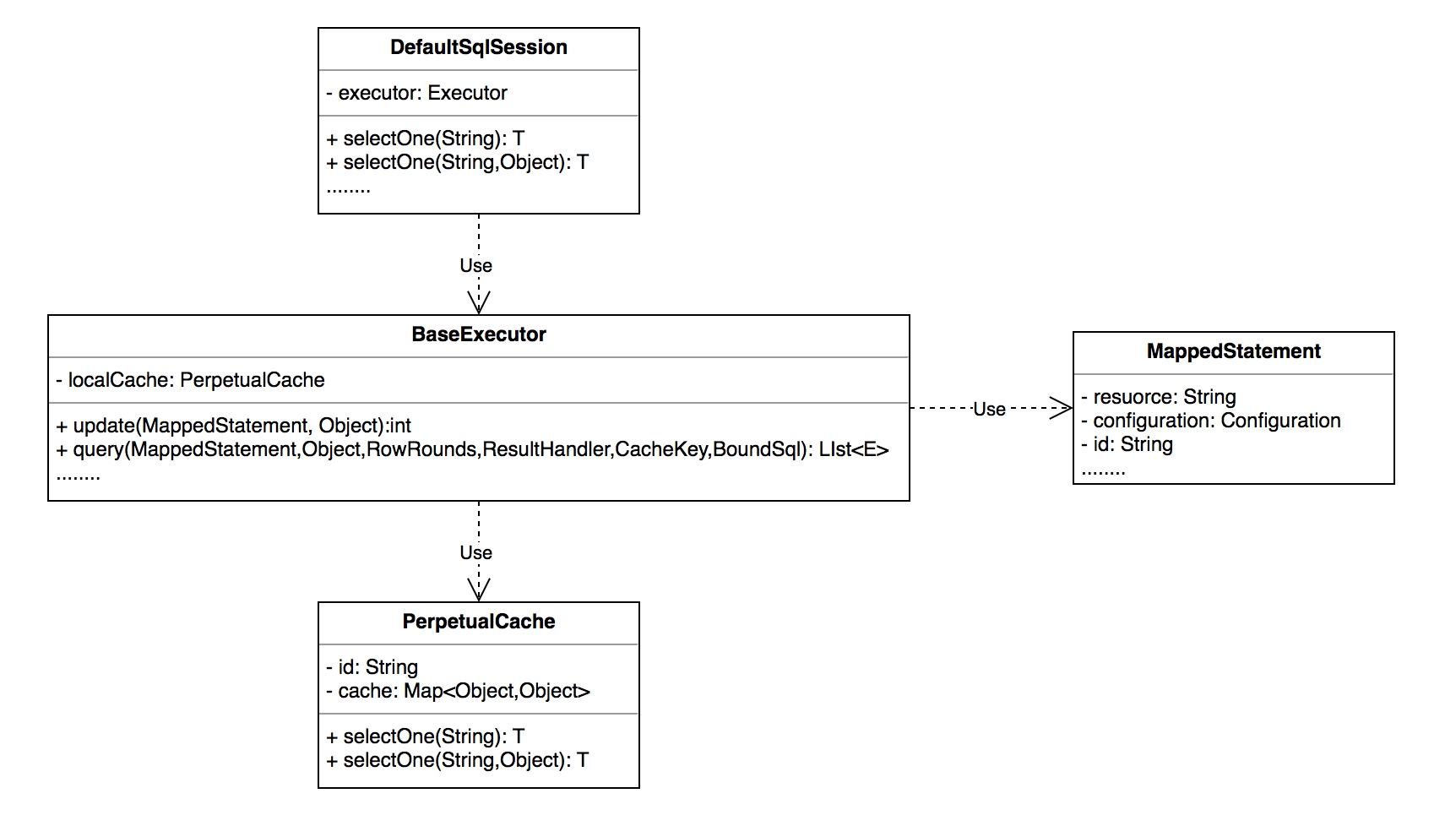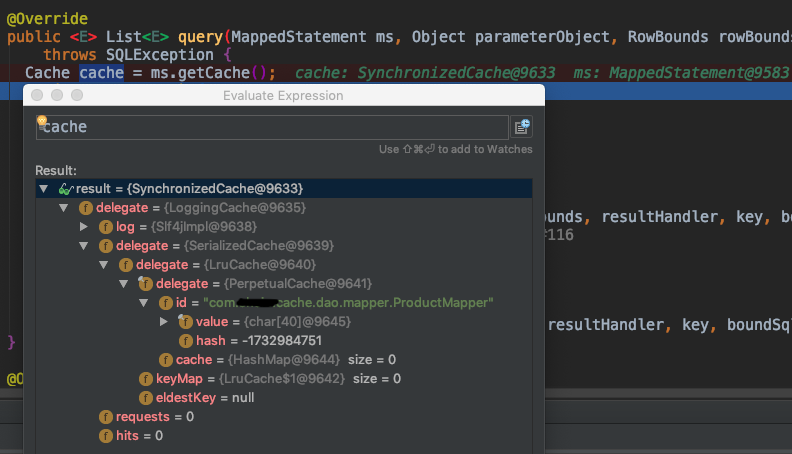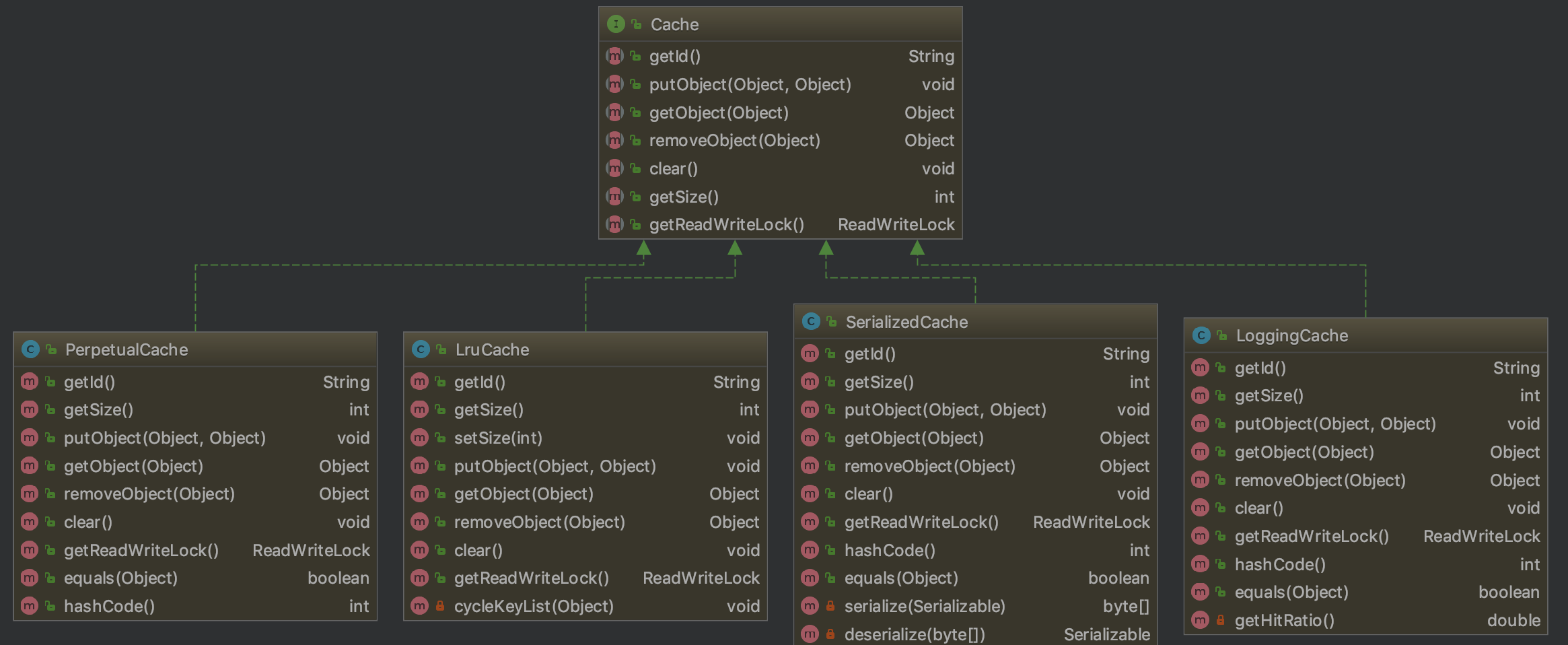一级缓存
介绍
在应用运行过程中,我们有可能在一次数据库会话中,执行多次查询条件完全相同的 SQL,MyBatis提供了一级缓存的方案优化这部分场景,如果是相同的SQL语句,会优先命中一级缓存,避免直接对数据库进行查询,提高性能。
一级缓存有两个选项:SESSION (默认)或 STATEMENT。SESSION级别在一个MyBatis会话中执行的所有语句,都会共享这一个缓存;STATEMENT级别,可以理解为缓存只对当前执行的这一个Statement有效。
开启方法
springboot配置文件开启 MyBatis 一级缓存方法:
mybatis:
configuration:
# 开启一级缓存,默认 session 级别(另一个是 statement)
local-cache-scope: session
原理
每个SqlSession中持有了Executor,Executor中有一个LocalCache。当用户发起查询时,MyBatis根据当前执行的语句生成MappedStatement,在Local Cache进行查询,如果缓存命中的话,直接返回结果给用户,如果缓存没有命中的话,查询数据库,结果写入Local Cache,最后返回结果给用户。

MappedStatement的Id、SQL的offset、SQL的limit、SQL本身以及SQL中的参数传入了CacheKey这个类,最终构成CacheKey。只要两条SQL的下列五个值相同,即可以认为是相同的SQL:
Statement Id + Offset + Limit + Sql + Params + environment
BaseExecutor中创建CacheKey的方法:
public CacheKey createCacheKey(MappedStatement ms, Object parameterObject, RowBounds rowBounds, BoundSql boundSql) {
if (closed) {
throw new ExecutorException("Executor was closed.");
}
CacheKey cacheKey = new CacheKey();
// Statement Id
cacheKey.update(ms.getId());
// Offset
cacheKey.update(rowBounds.getOffset());
// Limit
cacheKey.update(rowBounds.getLimit());
// Sql
cacheKey.update(boundSql.getSql());
List<ParameterMapping> parameterMappings = boundSql.getParameterMappings();
TypeHandlerRegistry typeHandlerRegistry = ms.getConfiguration().getTypeHandlerRegistry();
// Params
for (ParameterMapping parameterMapping : parameterMappings) {
if (parameterMapping.getMode() != ParameterMode.OUT) {
Object value;
String propertyName = parameterMapping.getProperty();
if (boundSql.hasAdditionalParameter(propertyName)) {
value = boundSql.getAdditionalParameter(propertyName);
} else if (parameterObject == null) {
value = null;
} else if (typeHandlerRegistry.hasTypeHandler(parameterObject.getClass())) {
value = parameterObject;
} else {
MetaObject metaObject = configuration.newMetaObject(parameterObject);
value = metaObject.getValue(propertyName);
}
cacheKey.update(value);
}
}
if (configuration.getEnvironment() != null) {
// environment
cacheKey.update(configuration.getEnvironment().getId());
}
return cacheKey;
}
二级缓存
介绍
二级缓存是在多个SqlSession之间共享的缓存。二级缓存开启后,同一个namespace下的所有操作语句,都影响着同一个Cache,即二级缓存被多个SqlSession共享,是一个全局的变量。
当开启缓存后,数据的查询执行的流程就是二级缓存 -> 一级缓存 -> 数据库。
开启方法
在 springboot 的配置文件中写入:
mybatis:
configuration:
# 开启二级缓存
cache-enabled: true
Mapper配置文件中写入:
<cache/>
可配置的属性有:
- type:cache使用的类型,默认是
PerpetualCache,在一级缓存中默认也使用这个类。 - eviction: 定义回收的策略,常见的有
FIFO,LRU(默认)。 - flushInterval: 配置一定时间后自动刷新缓存,单位是毫秒。
- size: 最多缓存对象的个数,默认
1024个。 - readOnly: 是否只读,若配置可读写,则需要对应的实体类能够序列化。
- blocking: 若缓存中找不到对应的key,是否会一直blocking,直到有对应的数据进入缓存。
如果使用默认的PerpetualCache会导致出现多个namespace中的数据不一致现象。
原理
CachingExecutor内部持有TransactionalCache,执行 SQL 时会先去查看缓存:
// 执行SQL语句
@Override
public <E> List<E> query(MappedStatement ms, Object parameterObject, RowBounds rowBounds, ResultHandler resultHandler, CacheKey key, BoundSql boundSql)
throws SQLException {
Cache cache = ms.getCache(); // 获取缓存
if (cache != null) {
flushCacheIfRequired(ms); // insert/update/delete语句进入此方法刷新缓存
if (ms.isUseCache() && resultHandler == null) {
ensureNoOutParams(ms, parameterObject, boundSql);
@SuppressWarnings("unchecked")
List<E> list = (List<E>) tcm.getObject(cache, key); // 从缓存取数据
if (list == null) {
list = delegate.<E> query(ms, parameterObject, rowBounds, resultHandler, key, boundSql);
tcm.putObject(cache, key, list); // 没有取到缓存,把结果放入 cache,这里包装了 Cache
}
return list;
}
}
return delegate.<E> query(ms, parameterObject, rowBounds, resultHandler, key, boundSql);
}
// 清除缓存
private void flushCacheIfRequired(MappedStatement ms) {
Cache cache = ms.getCache();
if (cache != null && ms.isFlushCacheRequired()) {
tcm.clear(cache);
}
}
Cache cache = ms.getCache()获取缓存时查看 cache 到底是什么:

因为我没有指定 cache 类型,最终使用了默认的PerpetualCache。
使用缓存时,就是直接调用 Cache 接口定义的方法,如获得缓存调用 getObject、删除调用 removeObject:

TransactionalCache内部持有一个 Map,包装了 Cache:
public class TransactionalCacheManager {
// 缓存
private Map<Cache, TransactionalCache> transactionalCaches = new HashMap<Cache, TransactionalCache>();
public void clear(Cache cache) {
getTransactionalCache(cache).clear();
}
public Object getObject(Cache cache, CacheKey key) {
return getTransactionalCache(cache).getObject(key);
}
public void putObject(Cache cache, CacheKey key, Object value) {
getTransactionalCache(cache).putObject(key, value);
}
public void commit() {
for (TransactionalCache txCache : transactionalCaches.values()) {
txCache.commit();
}
}
public void rollback() {
for (TransactionalCache txCache : transactionalCaches.values()) {
txCache.rollback();
}
}
private TransactionalCache getTransactionalCache(Cache cache) {
TransactionalCache txCache = transactionalCaches.get(cache);
if (txCache == null) {
txCache = new TransactionalCache(cache);
transactionalCaches.put(cache, txCache);
}
return txCache;
}
}
CacheKey 的规则和一级缓存还是一样的。
使用 Redis 作为二级缓存
-
继承 Cache 接口,实现对应方法。
-
在
<cache/>中指定属性type为实现类:<!-- 开启基于redis的二级缓存 --> <cache type="com.xxx.cache.util.RedisCache"/> -
在查询上标记是否使用、刷新缓存:
<!--使用缓存--> <select id="select" resultType="com.xxx.cache.dao.model.Product" useCache="true"> SELECT * FROM products WHERE id = #{id} </select> <!--刷新缓存--> <update id="update" parameterType="com.xxx.cache.dao.model.Product" flushCache="true"> UPDATE products SET name = #{name}, price = #{price} WHERE id = #{id} </update>
样例请看。
Spring Cache – 注解驱动的缓存
开启
Springboot 开启缓存要提供一个 CacheManager,注解@EnableCaching 开启缓存:
@Configuration
@EnableCaching
public class RedisConfig extends CachingConfigurerSupport {
@Bean("cache")
public CacheManager cacheManager(RedisTemplate redisTemplate) {
return new RedisCacheManager(redisTemplate);
}
@Bean
@SuppressWarnings("unchecked")
public RedisTemplate redisTemplate(RedisConnectionFactory factory) {
RedisTemplate template = new RedisTemplate();
template.setConnectionFactory(factory);
Jackson2JsonRedisSerializer jackson2JsonRedisSerializer = new Jackson2JsonRedisSerializer(Object.class);
ObjectMapper om = new ObjectMapper();
om.setVisibility(PropertyAccessor.ALL, JsonAutoDetect.Visibility.ANY);
om.enableDefaultTyping(ObjectMapper.DefaultTyping.NON_FINAL);
jackson2JsonRedisSerializer.setObjectMapper(om);
template.setValueSerializer(jackson2JsonRedisSerializer);
template.afterPropertiesSet();
return template;
}
}
注解
Spring的缓存是围绕切面构建的,所有注解都能运用在方法或类上。当将其放在单个方法上时,缓存只会运用到这个方法上。如果注解放在类级别的话,那么缓存就会应用到类的所有方法上。
| 注解 | 描述 |
|---|---|
| @Cacheable | 在调用方法之前,首先在缓存中查找方法的返回值。如果能够找到,就会返回缓存。否则的话方法就会被调用,返回值会放到缓存中。 |
| @CachePut | 将方法的返回值放到缓存中。在方法的调用前并不会检查缓存,方法始终都会被调用。 |
| @CacheEvict | 将方法的返回值放到缓存中。在方法的调用前并不会检查缓存,方法始终都会被调用。 |
| @Caching | 分组的注解,能够同时应用多个其他的缓存注解。 |
注解的属性
@Cacheable和@CachePut注解都可以填充缓存,但是它们的工作方式略有差异。@Cacheable首先在缓存中查找条目,如果找到了匹配的条目,那么就不会调用方法。如果没有找到匹配的条目,方法会被调用并且返回值要放到缓存中。而@CachePut不会在缓存中检查匹配的值,目标方法总是会被调用,并将返回值添加到缓存中。
| 属性 | 类别 | 描述 |
|---|---|---|
| value | String[] | 要使用的缓存名称 |
| condition | String | SpEL表达式,如果得到的值是false的话,不会将缓存应用到方法调用上 |
| key | String | SpEL表达式,用来计算自定义的缓存key |
| unless | String | SpEL表达式,用来计算自定义的缓存key |